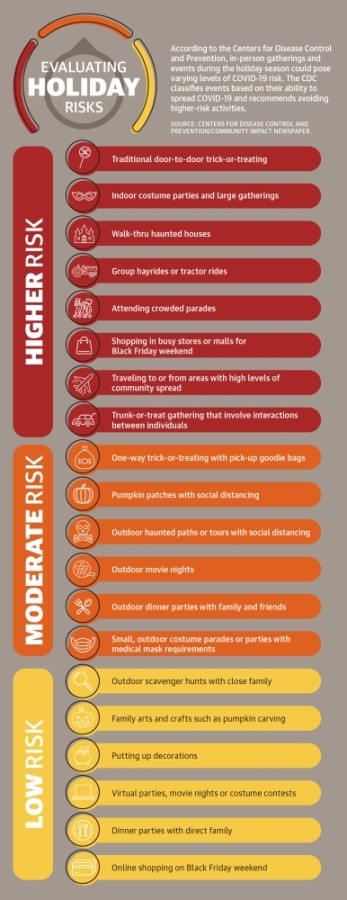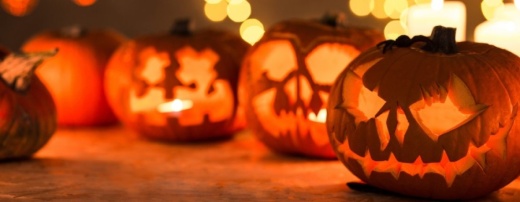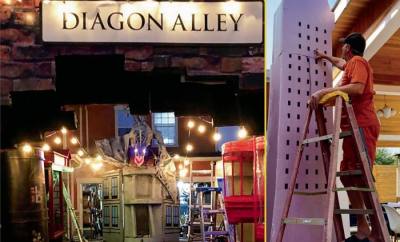Initially started as a way to cheer up his wife as she was going through chemotherapy, Pace said the family has kept up the tradition to brighten people’s day and to raise donations for local charities.
However, with the coronavirus pandemic still active across the country, he said he knew a traditional haunted house experience was not going to be safe in 2020.
“It’s really immersive. People walk through our house; everybody’s in costumes; there’s a huge line of people waiting to take pictures,” Pace said. “It’s really a lot of contact, and as we thought about what was going on this year, we realized there was no way we’re going to be able to have that kind of display.”
As many in the community will do this holiday season, Pace has pivoted to provide what he said he believes is a safer option for the community. Since August, he has been constructing a replica of Hogwarts, the magical school and castle from Harry Potter. By building the massive structure on his lawn, he said he hopes to allow residents to safely visit from the sidewalk or their cars through the fall.
Pandemic dangers do, however, remain for those looking for fall activities to enjoy. Dr. Stanley Spinner, the vice president and chief medical officer at Texas Children’s Pediatrics and Texas Children’s Urgent Care, said Halloween could be a recipe for a lot of individuals to get sick.
“As we get into the holidays, this is the time we have to really double down and just stick with the precautions we’ve been taking,” Spinner said.
 Dangers in trick-or-treating
Dangers in trick-or-treatingAccording to Austin Public Health, as long as the county is under Stage 3 coronavirus risk guidelines, individuals should avoid all social gatherings, which would include gatherings outside of the home such as going door to door for Halloween.
“Going door to door, ringing the doorbell and having people hand you candy just isn’t something that any medical experts are recommending because of the obvious exposure risks,” Spinner said.
Dr. Goddy Corpuz, a pediatrician Baylor Scott & White Clinic-Cedar Park, said COVID-19 could be easily spread in a traditional Halloween setting. While Halloween costumes could include a mask, he said costume masks will not prevent the spread of germs and should not be used as a substitute for a medical-grade mask.
“I personally am not going to have my kids trick or treat in the community where I live,” Corpuz said.
Other outdoor fall activities that attract a crowd or require interactions with others could also pose a risk. Corpuz said that according to Centers for Disease Control and Prevention guidelines, activities such as hayrides, mazes or visiting pumpkin patches are considered risky. For fall activities, organizers should follow social distancing, capacity limits and masking guidelines, according to APH.
“Traditional trick-or-treating and those events are just not going to be safe this year, so we have to look for different ways that we can still make the holiday enjoyable,” Spinner said.
Making alternative plans
APH suggests residents making new traditions this fall including carving pumpkins with the family at home and making scarecrows and other fall decorations.
Instead of trick-or-treating, Corpuz said he is planning a scavenger hunt at his house. By keeping the celebration’s size limited and the guest list in the family, he said he hopes he can enforce safe practices and minimize risk. Other activities could include watching a Halloween-themed movie or other outdoor activities that do not require person-to-person contact, he said.
For Pace, his Hogwarts display will be a way to keep up his Harry Potter tradition while staying safe. Compared to the haunted house of years past, his lawn display will allow people to observe as they drive by the property.
“The yard will be roped off and barricaded,” he said. “We’re going to have signs and will be asking you not to loiter.”
Pace said he also plans to keep the display up until Christmas so those wanting to visit are not pressured into coming on Halloween, when it is expected to be the most busy.
Distributing candy
Although a family may decide not to participate in trick-or-treating this year, that does not mean neighbors will not be roaming the streets Oct. 31. Both doctors suggested families not distribute candy directly to people or right from their doors.
“If someone rings your doorbell or knocks on your door, I would not be opening the door because you don’t know who’s there; you don’t know if they’re wearing a mask; and you don’t know what their physical condition is,” Spinner said. “Even though it's a brief exposure, that adds up.”
Similarly, he said that setting candy in a large bowl like years past would not be safe because it will allow germs to spread as people visit. Instead, he said spreading individually wrapped pieces of candy across a table outside could be safer.
Stay home when feeling sick
According to APH, COVID-19 is not the only respiratory disease or condition that could be prevalent this fall, with both flu and allergy season beginning and carrying similar symptoms.
“If someone has a sore throat, cough or runny nose, I'd recommend just staying at home,” Corpuz said. “There's a lot of overlap in symptoms, and if you are not sure what you have you could be exposing other people.”
Both Corpuz and Spinner said they have seen a bit of “COVID-19 fatigue” when it comes to following guidelines as 2020 has moved along. While COVID-19 conditions could get better in the future, for now, they both said to continue practicing safety and hygiene guidelines.
“You can't really be too careful because it is a very contagious virus, and one person getting it can continue to spread it to others,” Spinner said.






